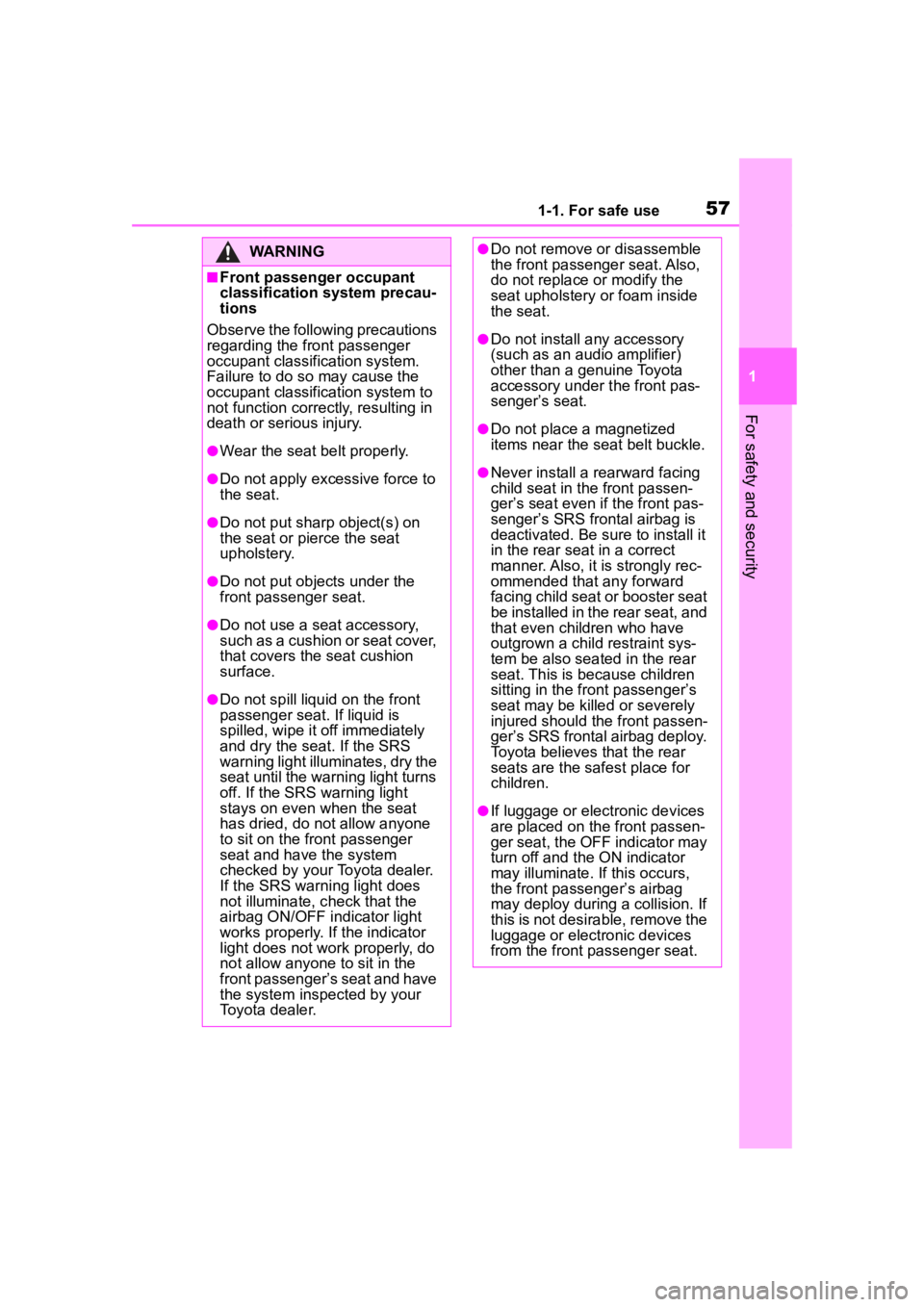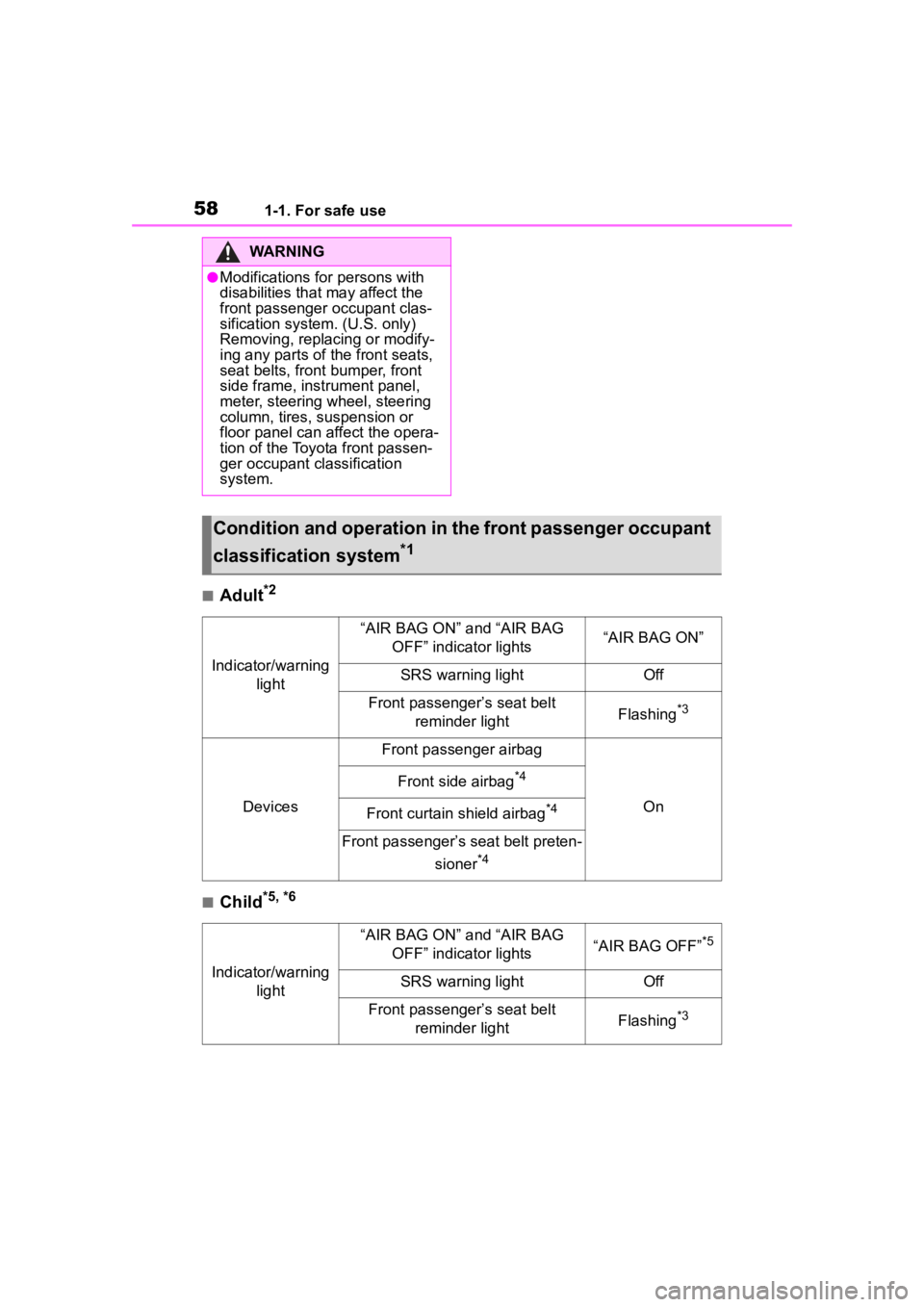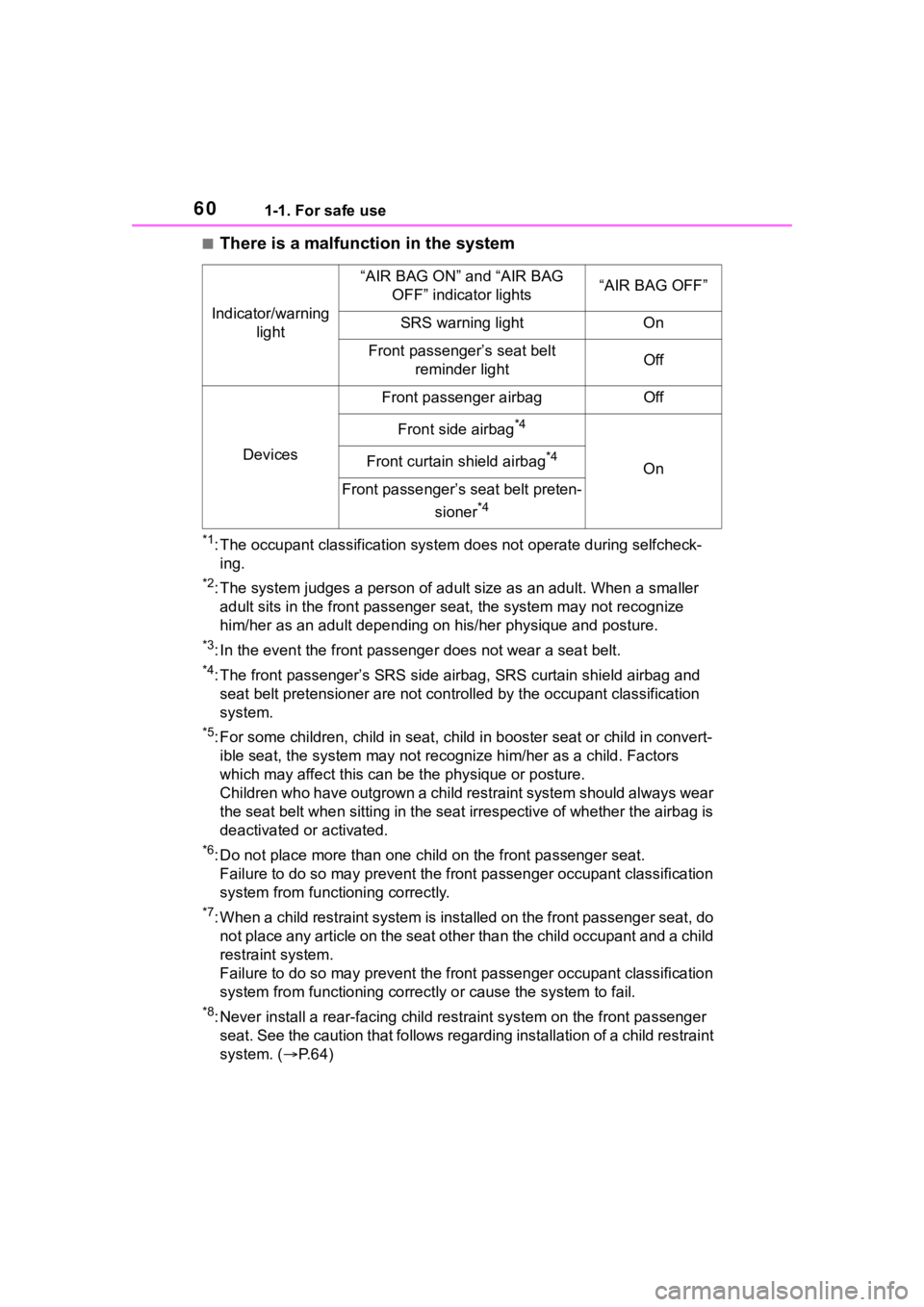Page 56 of 449
561-1. For safe use
The front passenger’s frontal airbag ON and OFF indicators show
you the status of the front passenger’s SRS frontal airbag. When the
engine switch is turned to ON, both the ON and OFF indicators illu-
minate while the system is checked, after which both indicators turn
off.
After that, one of the indicators illuminates depending on the status
of the front passenger’s SRS frontal airbag determined by the T oyota
advanced frontal airbag monitoring system.
SRS warning light
Front passenger’s seat belt reminder light
“AIR BAG OFF” indicator light
“AIR BAG ON” indicator light
Front passenger occupant classification system
Your vehicle is equipped with a front passenger occupant
classification system. This system detects the conditions of
the front passenger seat and activates or deactivates the front
passenger airbag.
System components
A
C
D
Page 57 of 449

571-1. For safe use
1
For safety and security
WARNING
■Front passenger occupant
classification system precau-
tions
Observe the following precautions
regarding the front passenger
occupant classification system.
Failure to do so may cause the
occupant classifi cation system to
not function correctly, resulting in
death or serious injury.
●Wear the seat belt properly.
●Do not apply excessive force to
the seat.
●Do not put sharp object(s) on
the seat or pierce the seat
upholstery.
●Do not put objects under the
front passenger seat.
●Do not use a seat accessory,
such as a cushion or seat cover,
that covers the seat cushion
surface.
●Do not spill liqui d on the front
passenger seat. If liquid is
spilled, wipe it off immediately
and dry the seat. If the SRS
warning light illumi nates, dry the
seat until the warning light turns
off. If the SRS warning light
stays on even when the seat
has dried, do not allow anyone
to sit on the front passenger
seat and have the system
checked by your Toyota dealer.
If the SRS warning light does
not illuminate, check that the
airbag ON/OFF indicator light
works properly. If the indicator
light does not work properly, do
not allow anyone to sit in the
front passenger’s seat and have
the system inspected by your
Toyota dealer.
●Do not remove or disassemble
the front passenger seat. Also,
do not replace or modify the
seat upholstery or foam inside
the seat.
●Do not install any accessory
(such as an audio amplifier)
other than a genuine Toyota
accessory under t he front pas-
senger’s seat.
●Do not place a magnetized
items near the seat belt buckle.
●Never install a rearward facing
child seat in the front passen-
ger’s seat even if the front pas-
senger’s SRS frontal airbag is
deactivated. Be sure to install it
in the rear seat in a correct
manner. Also, it is strongly rec-
ommended that any forward
facing child seat or booster seat
be installed in the rear seat, and
that even children who have
outgrown a child restraint sys-
tem be also seated in the rear
seat. This is because children
sitting in the front passenger’s
seat may be killed or severely
injured should the front passen-
ger’s SRS frontal airbag deploy.
Toyota believes that the rear
seats are the safest place for
children.
●If luggage or electronic devices
are placed on the front passen-
ger seat, the OFF indicator may
turn off and the ON indicator
may illuminate. If this occurs,
the front passenger’s airbag
may deploy during a collision. If
this is not desirable, remove the
luggage or electronic devices
from the front passenger seat.
Page 58 of 449

581-1. For safe use
■Adult*2
■Child*5, *6
WARNING
●Modifications for persons with
disabilities that may affect the
front passenger occupant clas-
sification system. (U.S. only)
Removing, replacing or modify-
ing any parts of the front seats,
seat belts, front bumper, front
side frame, instrument panel,
meter, steering wheel, steering
column, tires, suspension or
floor panel can affect the opera-
tion of the Toyota front passen-
ger occupant classification
system.
Condition and operation in the front passenger occupant
classification system
*1
Indicator/warning light
“AIR BAG ON” and “AIR BAG OFF” indicator lights“AIR BAG ON”
SRS warning lightOff
Front passenger’s seat belt reminder lightFlashing*3
Devices
Front passenger airbag
On
Front side airbag*4
Front curtain shield airbag*4
Front passenger’s seat belt preten-
sioner
*4
Indicator/warning light
“AIR BAG ON” and “AIR BAG OFF” indicator lights“AIR BAG OFF”*5
SRS warning lightOff
Front passenger’s seat belt reminder lightFlashing*3
Page 59 of 449
591-1. For safe use
1
For safety and security■Child restraint system with infant*6, *7, *8
■Unoccupied
Devices
Front passenger airbagOff
Front side airbag*4
OnFront curtain shield airbag*4
Front passenger’s seat belt preten-sioner
*4
Indicator/warning light
“AIR BAG ON” and “AIR BAG OFF” indicator lights“AIR BAG OFF”*9
SRS warning light
OffFront passenger’s seat belt reminder light
Devices
Front passenger airbagOff
Front side airbag*4
OnFront curtain shield airbag*4
Front passenger’s seat belt preten-
sioner
*4
Indicator/warning light
“AIR BAG ON” and “AIR BAG OFF” indicator lights“AIR BAG OFF”
SRS warning light
OffFront passenger’s seat belt reminder light
Devices
Front passenger airbagOff
Front side airbag*4
OnFront curtain shield airbag*4
Front passenger’s seat belt preten-
sioner
*4
Page 60 of 449

601-1. For safe use
■There is a malfunction in the system
*1: The occupant classification system does not operate during selfcheck-
ing.
*2: The system judges a person of adult size as an adult. When a smaller
adult sits in the front passenger seat, the system may not recognize
him/her as an adult depending on his/her physique and posture.
*3: In the event the front passenge r does not wear a seat belt.
*4: The front passenger’s SRS side airbag, SRS curtain shield airbag and
seat belt pretensioner are not c ontrolled by the occupant classification
system.
*5: For some children, child in seat, child in booster seat or chi ld in convert-
ible seat, the system may not recognize him/her as a child. Fac tors
which may affect this can be the physique or posture.
Children who have outgrown a child restraint system should alwa ys wear
the seat belt when sitting in the seat irrespective of whether the airbag is
deactivated o r activated.
*6: Do not place more than one child on the front p assenger seat.
Failure to do so may prevent the front passenger occupant class ification
system from functioning correctly.
*7: When a child restraint system is installed on the front passen ger seat, do
not place any article on the seat other than the child occupant and a child
restraint system.
Failure to do so may prevent the front passenger occupant class ification
system from functioning correctly or cause the system to fail.
*8: Never install a rear-facing ch ild restraint system on the front passenger
seat. See the caution that follows regarding installation of a child restraint
system. ( P.64)
Indicator/warning
light
“AIR BAG ON” and “AIR BAG OFF” indicator lights“AIR BAG OFF”
SRS warning lightOn
Front passenger’s seat belt reminder lightOff
Devices
Front passenger airbagOff
Front side airbag*4
OnFront curtain shield airbag*4
Front passenger’s seat belt preten-
sioner
*4
Page 62 of 449

621-1. For safe use
Exhaust gas precau-
tions
Harmful substance to the
human body is included in
exhaust gases if inhaled.
WARNING
Exhaust gases include harmful
carbon monoxide (CO), which is
colorless and odorless. Observe
the following precautions.
Failure to do so may cause
exhaust gases enter the vehicle
and may lead to an accident
caused by light-headedness, or
may lead to death or a serious
health hazard.
■Important points while driving
●Keep the trunk lid closed.
●If you smell exhaust gases in
the vehicle even when the trunk
lid is closed, open the windows
and have the vehicle inspected
at your Toyota dealer as soon
as possible.
■When parking
●If the vehicle is in a poorly venti-
lated area or a closed area,
such as a garage, stop the
engine.
●Do not leave the vehicle with
the engine on for a long time.
If such a situation cannot be
avoided, park the vehicle in an
open space and ensure that
exhaust fumes do not enter the
vehicle interior.
●Do not leave the engine running
in an area with snow build-up,
or where it is snowing. If snow-
banks build up around the vehi-
cle while the engine is running,
exhaust gases may collect and
enter the vehicle.
■Exhaust pipe
The exhaust system needs to be
checked periodically. If there is a
hole or crack caused by corro-
sion, damage to a joint or abnor-
mal exhaust noise, be sure to
have the vehicle inspected and
repaired by your Toyota dealer.
Page 83 of 449
83
2
2
Vehicle status information and indicators
Vehicle status informationand indicators
.2-1. Instrument cluster
Warning lights and indica-tors ............................... 84
Gauges and meters ....... 88
Multi-information display ..................................... 93
Page 84 of 449
842-1. Instrument cluster
2-1.Instrument cluster
For the purpose of explanation, the following illustrations display all
warning lights and indicators illuminated.
Warning lights inform the driver
of malfunctions in the indicated
vehicle systems.
War ning lights and indicators
The warning lights and indicators on the instrument cluster
and overhead console inform the driver of the status of the
vehicle’s various systems.
Warning lights and indicators displayed on the instru-
ment cluster
Warning lights
(U.S.A.)
Brake system warning
light
*1 ( P.348)
(Canada)
Brake system warning
light
*1 ( P.348)
(red)
High coolant temperature
warning light
*1 ( P.348)
Charging system warning
light
*1 ( P.348)
Low engine oil pressure
warning light
*1 ( P.349)
(U.S.A.)
Malfunction indicator
lamp
*1 ( P.349)
(Canada)
Malfunction indicator
lamp
*1 ( P.349)
SRS warning light
*1
( P.54, 349)
(U.S.A.)
ABS warning light*1
( P.349)